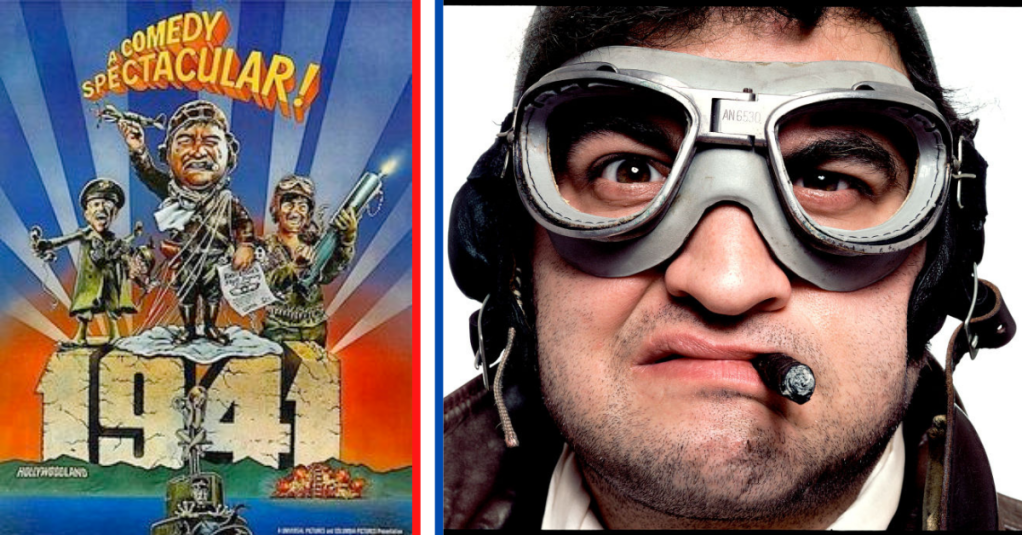

Very few movies have as much going for them at the outset as 1979’s World War II comedy “1941.” Steven Spielberg was the director and had just completed “Close Encounters of the Third Kind,” and directed “Jaws” before that.
Actors John Belushi and Tim Matheson were fresh off of their roles in “Animal House,” and to top it off, their “1941” characters behaved identically to their Animal House roles of wild man Bluto Blutarsky and playboy Eric “Otter” Stratton. Belushi’s fellow Saturday Night Live cast member and future Blues Brother partner Dan Aykroyd had a major role, along with up and comer, and future comedic superstar John Candy. The rest of the cast was salted with veteran actors and legends such as Christopher Lee, Toshiro Mifune, Ned Beatty, and Robert Stack. Several legendary actors and directors took non-attributed cameo roles, including John Landis and James Caan, and the musical director was John Williams, who at the time had only received three Oscars for his work on Fiddler on the Roof, Jaws, and Star Wars.
The film is set in a very jittery southern California, on high alert for a Japanese invasion after the surprise attack on Pearl Harbor, Hawaii, earlier in the month. Aykroyd leads a misfit crew of California National Guard soldiers, charged with manning an anti-aircraft gun overlooking the Pacific Ocean in sight of the Santa Monica Pier. Meanwhile, Army pilot “Wild Bill” Kelso (Belushi) has been flying his iconic shark-mouthed P-40 fighter down the length of California, chasing phantom Japanese aircraft. Captain Burkhead (Matheson), flight school washout and aide to real-live General Joseph Stillwell, is in amorous pursuit of the general’s new secretary, who has a “thing” for airplanes in flight. Oh, and an Imperial Japanese Navy submarine, captained by Mifune and carrying Nazi U-boat liaison officer Christopher Lee, arrives off of the coast and begins lurking for an opportunity to attack.
These various elements eventually combine to produce a false nighttime air raid over Los Angeles that sets anti-aircraft guns blazing during both a real submarine attack on the Santa Monica Pier Ferris wheel and a race riot between servicemen and Mexican- American civilian “Zoot suiters.” While these events might sound par for the course for a mindless, slapstick 1970s comedy movie, all three events have a basis in actual World War II facts.
On the evening of February 23rd, 1942, a Japanese submarine, the I-17, surfaced off the coast of Santa Barbara, California.
Stopping opposite the Ellwood Oil Field, the submarine crew began firing their 14 cm/140mm deck gun at a storage tank visible in the dark. The tank held highly volatile aviation fuel; however, only minor damage to some oil field equipment resulted after a 20-minute barrage from the submarine. A small crew on duty heard the explosions and reported a surface warship close to shore to the local police. Fortunately, no one was injured.

The shelling constituted the first Axis military attack on the U.S. mainland in World War II and caused significant impacts elsewhere. First, the attack set off an “invasion panic” across the U.S. West Coast. The very next night, the “Battle of Los Angeles” began.
Over the evening of February 24th and into the early morning of the 25th, what was also known as the “Great Los Angles Air Raid”, broke out over southern California. A 1949 investigation postulated that a rapidly rising internally illuminated weather balloon released over Los Angeles on the night of Feb. 24th was caught in a searchlight beam, and nervous, inexperienced antiaircraft gunners, undoubtedly aware of the real submarine attack the night before, cut loose. Air raid sirens were sounded in Los Angeles County, and in all, over 1,400 shells were expended, damaging some buildings and homes. Unfortunately, five deaths were indirectly attributed to the episode, three by auto accident and two fatal heart attacks.
Zoot suits consisted of high-waisted, baggy trousers, and a long coat with wide lapels and wide padded shoulders, topped by a very wide-brimmed fedora-style hat. The style was popular with young men of color, and some white youth in the war years, and was part of the “hepcat” jazz musical culture. Several Zoot Suit riots took place during June 1943 in Los Angeles, involving servicemen and young Latino and Mexican American Angelenos. Over a dozen wartime race-related riots also took place that summer in cities such as Mobile, Alabama; Beaumont, Texas; Detroit, Michigan; and New York City.
While “1941” failed to catch hold as a classic comedy movie like many others involving members of its distinguished cast, it did well at the box office. The authentic military uniforms and equipment used are of note, considering Spielberg’s next major military-themed movie would be 1998’s “Saving Private Ryan.”
